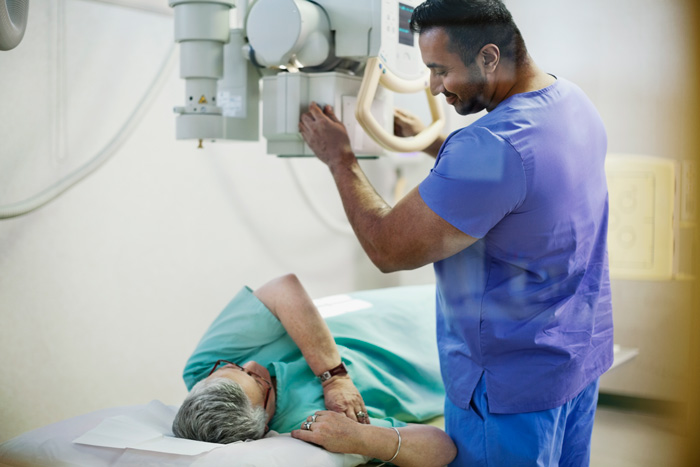Find A Clinic Near You

Loading Interactive Map...
Whether you broke an arm as a child or suffered from a cavity as an adult, most of us have had an x-ray of some sort in our life.
While it is not an uncommon occurrence, many people don’t know much about this form of radiation.
Below are a few things to know about x-rays, including what they are needed for, how they work and how to prepare for one.
If you're in need of x-rays, CareNow® Urgent Care can help!


X-rays are easily able to detect dense material such as a tumor, bone or metal fragment. An x-ray moves effortlessly through air and soft tissue in the body, but is stopped any time it approaches a mass.
The bigger the mass, the more rays are absorbed. Because of this, it is easy to differentiate a tumor from a bone due to the amount of x-ray absorbed.
A trained physician, known as a radiologist, will study the x-ray and inform the provider of the results.

A normal x-ray (known as a fixed plate x-ray) requires no special preparation.
Although, it is smart to wear loose, comfortable clothing that you can move around in easily. (Some providers will ask you to change into a hospital gown for the x-ray.)

For children receiving their first x-ray, it is smart to walk them through what will happen.
There are a few ways you can help your child prepare for an x-ray.
One of the best things you can do to help prepare your child for his or her upcoming x-ray appointment is to let them know exactly what to expect.
Tell your child that he or she will be awake at all times during the exam.
Let your child know that x-rays aren’t painful and that he or she can return to regular activities afterward.
There are a number of children’s books to teach your child about the x-ray experience.
A couple of great book options are Jessica’s X-Ray and Curious George Goes to the Hospital.
Teach your child about x-rays with a life-like x-ray machine, which can be purchased at a toy store.
These machines can be fun for your child while also helping them learn the benefits of an x-ray.
Most x-rays are done in one of three ways—standing up against a backboard, sitting in a chair at the end of the table and lying down on a table.
Use your child’s toys to create a pretend x-ray room and allow the stuffed animals to get “x-rays.”

Because x-rays use minor amounts of radiation in order to create the images of your body, it is essential that you tell your provider if you are pregnant.
The radiation level is so small that it is considered to be safe for adults; however, babies should not receive an x-ray because of this exposure.

During the x-ray procedure, you will be asked to hold your body in certain positions while the images are being taken.
If you are suffering from a painful condition, like a broken bone, it is possible you could experience slight discomfort during the exam.
Because of this, your provider may recommend you take pain medication beforehand. Some people may experience side effects when asked to ingest the contrast dye.
Once your provider has collected the x-ray images, you should be able to change back into your normal clothing. Depending on the situation, your provider will likely encourage you to go about your routine daily activities.
If you are physically unable, he or she may recommend you rest while you await your results.

Typically, your results will be available the same day as the procedure. However, sometimes results can take a few days.
Once your provider has reviewed your results, additional testing may be ordered depending on the results.
An example of additional testing includes imaging scans, blood tests and other diagnostic measures.

What many people don’t know about x-rays is that they can also be done at an urgent care center, such as CareNow®. Each CareNow® urgent care facility is equipped to provide complete x-ray services to diagnose fractures.
CareNow® also has earned the distinction of Accredited Urgent Care Center from our industry’s association, Urgent Care Association (UCA).

If you're looking to have X-rays done and need a fast and convenient way to get them, consider visiting your local CareNow®.
Disclaimer: Patient’s health can vary. While this content was approved for publishing by a CareNow® board certified medical director, always consult with your personal medical professional first before deciding that any medical advice from the internet is right for you.

Loading Interactive Map...